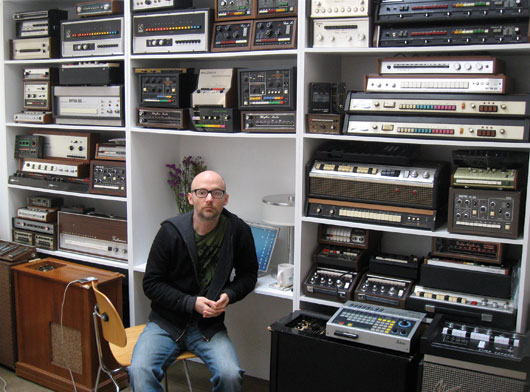Building an Iconic Sound: Moby
So how do you make a classic, fat rave bassline? If you’re Moby you go […]

So how do you make a classic, fat rave bassline? If you’re Moby you go out and buy Joey Beltram’s old analog synth. “About 18 years ago… there used to be a store called Rogue Music [in New York], and I bought this Jupiter 6 that no one wanted,” the techno legend recalls between mixing sessions for his new, as-yet-untitled album. “I saw Joey Beltram a few days later and I told him about it, and he told me that days before that he had gone in and sold his Jupiter 6 to Rogue Music, so I inadvertently bought his!” While it certainly isn’t the only way to make a killer bassline, Moby has over the years carved out a reliable method for doing such things. Want to make a ’90s hands-in-the-air club jam? Here’s what Moby recommends.
1 – Buy Joey Beltram’s old Roland Jupiter 6 synthesizer
The Jupiter 6 is basically an old Roland analog synth. It has, I think, three different oscillators. It’s a big, heavy monster. Analog synths all kind of do the same thing, but this one just has some really weird filters and processors that do very bizarre things to the actual sound. I think Joey’s iconic rave tracks all used this synth. On my first single, “Go,” I did a remix called the Rainforest Mix, and it had this monstrous, noisy, distorted bassline on it that was made with the Jupiter 6. There’s nothing tasteful about it. Like, if you were a well-mannered house producer and you wanted a delicate, subtle listen bassline, you wouldn’t use [this synth]. If you wanted something that sounded like shards of glass bouncing around in someone’s brain, that’s what this is designed for.
2 – Plug it into a Zvex distortion pedal and/or an Electro-Harmonix pitch-shifting box
Zvex pedals are made by this one guy, and he hand-silkscreens the art on all the pedals. They have really great circuitry so they sound wonderful… The actual synth itself makes some really interesting sounds, but I recommend [combining it] with some Electro-Harmonix pitch-shifters. I like taking effects pedals that are designed for guitars and using them with synths. You just end up with completely random, odd results… There was an old rave track I made called “Thousand,” and I’m pretty sure I used an Electro-Harmonix pitch-shifter on that.
“Thousand”
3 – Run it through a DBX compressor
A lot of producers, when they try to make basslines, they think the key is to keep adding low end to it. And there’s a really strange, subtle relationship between how effective a bassline is and how much low end it actually contains. If it has too much low end, no one can play it. Compressors actually take a big low-end-y bassline sound and make it more usable. If there’s too much bass, it actually means that you won’t hear anything else in the song. For me, the simple combination of a good old analog synth, a couple of guitar distortion/pitch-shifter pedals, and a good compressor is what you’d ideally need to make interesting basslines. Again, not for making smooth, tasteful R&B basslines. It’s more for making iconic, three o’clock-in-the-morning-hands-in-the-air insane basslines.
4 – Make sure nothing digital is involved in the signal path
The truth is there are a lot of plug-ins and digital synths that make remarkable old rave basslines, and I think that they’re amazing. But for the purpose of this article, it’s almost too easy to use a plug-in to make a great-sounding rave bassline. It’s a lot more satisfying if you have an old analog synth that barely works, some crummy effects pedals, and a weird old DBX compressor—it’s going to have a personality and a character that will be untouchable by anything that would exist in the digital realm.
Moby’s album is due out next year on Mute.
For more Building an Iconic Sound, jump to our features with Mala and Squarepusher.

